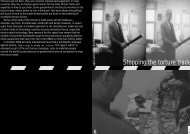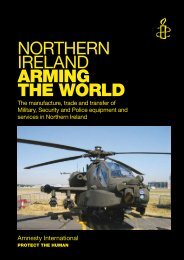CROWD CONTROL TECHNOLOGIES - Omega Research Foundation
CROWD CONTROL TECHNOLOGIES - Omega Research Foundation
CROWD CONTROL TECHNOLOGIES - Omega Research Foundation
Create successful ePaper yourself
Turn your PDF publications into a flip-book with our unique Google optimized e-Paper software.
police threw tear gas canisters inside the cathedral and then moved in wielding truncheons and<br />
describe how )an elderly opposition MP and several dozen individuals bled profusely as other victims<br />
groaned with pain among the pews.( 401 The police use of tear gas in the All Saints Cathedral was<br />
confirmed by other sources. 402 Following this incident, Amnesty International received the physical<br />
remains of tear gas canisters and plastic baton round canisters that had been used in Kenya. These<br />
canisters were identified as having been manufactured in the United Kingdom. 403 The use of tear gas<br />
within confined spaces or when people cannot physically leave an area could be seen as a form of<br />
punishment rather than dispersal. When tear gas has been used in these type of circumstances a<br />
number of severe injuries and death have been attributed to it. 404 405 It also appears that when the<br />
Kenyan police and security units have deployed tear gas, it is not used instead of physical beatings with<br />
batons, sticks or canes or as an alternative to lethal force but rather as an additional form of<br />
punishment. Following campaigning by human rights organisations, the British government announced<br />
in March 1998 that since election on May 1st, 1997, it had rejected 1.5 million worth of applications to<br />
export certain types of riot control equipment, including batons and tear gas, to the Kenyan police. 406<br />
Unfortunately, during 1998 human rights organisations continued to receive reports of human rights<br />
violations by the Kenyan security forces and remained concerned over the abuse of security equipment<br />
such as tear gas and plastic bullets in Kenya. Reports emerged of the violent suppression of a<br />
nationwide teachers strike in October 1998. The 6th October 1998 edition of the Daily Nation reports<br />
how police and members of the GSU (General Security Unit) attacked teachers with tear gas, whips<br />
and rungus (clubs). According to the report at least ten teachers in Thika district were injured and<br />
required treatment by the Kenyan Red Cross Society after being tear gassed by police. 407 It was<br />
reported in January 1999 that Kenyan riot police had used rubber bullets, teargas, baton charges and<br />
water cannon against students trying to plant trees in protest against deforestation. The report<br />
described the water cannon as spraying )acidic water( which probably denotes the use of chemical<br />
irritants in the water jet. 408<br />
On 10 June 1999, Amnesty International researchers witnessed around 2,000 peaceful protestors,<br />
led by human rights and church groups, demonstrate for peaceful democratic change in Kenya. One<br />
hundred yards from the Parliament building the head of the demonstration was stopped by a wall of<br />
police armed with riot shields and batons. The peaceful protestors sat on the ground and started to<br />
sing Christian songs. After less than 10 minutes police on horseback emerged and rode into the crowd<br />
of protestors, followed by police on foot who beat the peaceful crowd with sticks. The crowd reacted<br />
angrily, and some threw stones at the police. The police responded by firing tear gas into the crowd<br />
and the church grounds where some of the protestors had retreated to. 409 Over 100 canisters were<br />
fired in one hour. The police later moved in with water-cannon which fired a mixture of water and tear<br />
gas, reportedly an irritant and a dye.<br />
From the witness testimony and the physical remains of canisters, Amnesty International was able<br />
to identify that the manufacturer of the tear gas was a French-based company, Nobel Securite (formerly<br />
SNPE). 410 Further press reports suggested that the water cannon had been shipped to Kenya from<br />
either South Africa, Israel or France. 411 So even though the United Kingdom had refused export<br />
licences for tear gas and other riot control equipment to Kenya at least one French company stepped in<br />
to fill the vacuum.<br />
8.3 Indonesia. Over the last 20 years the international media and human rights organisations have<br />
documented numerous incidents where the Indonesian security forces have deployed both crowd<br />
control weapons and lethal force, often with severe consequences for peaceful protestors. However,<br />
with the exception of water cannon, what is striking is the lack of hard data on specific transfers of such<br />
crowd control weapons.<br />
The Indonesian security forces have deployed chemical irritants (CS), plastic baton rounds and<br />
water cannon that spray a mixture of water, chemical irritant and marker dye. 412 Both German and UK<br />
water cannon were identified as being deployed on the streets of Bandung in July 1996. 413 The German<br />
lxi




